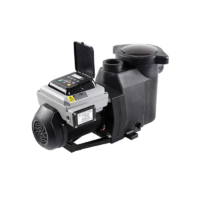10
Feb 2023
Variable Speed Pool Pumps

What pool pump should I choose?
For true energy savings, a variable speed pool pump is the way to go.
The advantage of a variable speed pump is that it can change its operating speed and set the operating time.
Most pool owners will set a lower, more efficient operating speed, but you can still set a timer to automatically control the speed. For example, you might want to increase the RPM when an automatic pool cleaner is working to help it clean more efficiently, and then restore the pool pump to a lower, more efficient speed.
As a result, the variable speed pump will save you money every year.
The main advantages of variable speed pumps are electricity cost savings and long-term maintenance, up to 90% in some cases.
Slow and steady
There are a lot of benefits that come from using a variable speed pump and running it at a lower speed.
Some of the advantages are:
- Each piece of pool or spa equipment can be run at its recommended flow rate for best performance
- lower flow rates through the filter will capture smaller particles resulting in cleaner water
- Better distribution of chemicals since the pump is running for a longer period of time
- Quieter operation
- Real energy savings
The Affinity Law
The common belief is, If I reduce the speed or horsepower of my pump by 50%, a homeowner will save 50 per cent on their energy bill. This is not how thigs really are. By reducing the speed of a pump by 50%, energy costs are slashed an amazing four times as much as the reduction in motor speed. This is known as the pump Affinity Law. This law is used to understand the relationship between several variables involved in pump performance (e.g. head, volumetric flow rate, pump speed and power).
Of course, running a pump at half speed will double the time it takes to completely cycle the pool water but, doubling the run time only uses a quarter of the energy the pump would require running at full speed. This results in a 75 per cent energy savings.
Variable speed pool pump benefits
Having a VSP allows homeowners to further save on electricity costs by simply reducing the pump’s speed even further. In other words, every time the pump’s motor speed is reduced, the Affinity Law applies again.
At capacity the FB Series 3HP Variable Speed Pump will draw 2400 watts and pump approximately 550 litres per minute (lpm) (145 gallons per minute [gpm]). (actual lpm/gpm will vary with the system head pressure). At 1,725 rpm the pump will draw 375 watts with about 310 lpm (82 gpm). This is an astounding saving of approximately 87 per cent.
Are Variable Speed Pool Pumps Worth The Money?
Yes! The ability to simply slow down your pump will cut down on energy use, but there’s a little more to it than that.
1. Variable-Speed Pool Pumps Consume Less Power
Pumps don’t need to run at full power all the time to keep your pool water clean. In fact, when you’re filtering your water, a pool pump running as a slower speed allows the filter to do a much better job. Pool pumps only need to operate at higher speeds when doing more demanding jobs, such as running water features or driving pool cleaners.
When you variable speed pool pump, you’ll have a higher up-front cost, but bigger savings over time. Typically, pool owners who switch to variable-speed pumps recover the cost of the pump in energy savings in less than two years.
You could save up to 90% on your electricity costs just by upgrading your pool pump.
2. They Help your Pool filter work more efficiently
By choosing a variable-speed pump, you can run it at lower speeds (although this may mean you need to run it for a longer period of time) during filtering hours, consuming less energy, filtering more effectively, and lowering your costs.